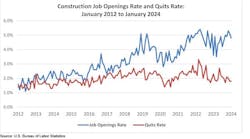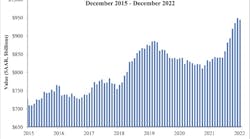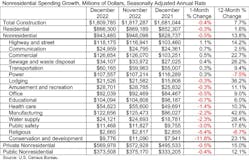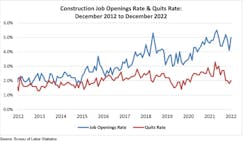PRESS RELEASES
WASHINGTON DC, ARLINGTON VA, February 1, 2023 -- Total construction spending decreased by 0.4% in December, yet industry job openings at the end of the month set a new high for December, according to two new federal data sets released this week. Industry economists suggest the divergence in the data was likely due more to winter weather than any true shift in the economy.
“The record number of job openings in construction compared to previous Decembers suggests contractors are bullish about their backlogs despite a dip in spending in December,” said Ken Simonson, chief economist for the Associated General Contractors of Amercia (AGC). “Some of the downturn may be due to unusually bad weather rather than a shrinking market.”
Added Chief Economist Anirban Basu, chief economist for Associated Builders and Contractors (ABC), “The 5% of industrywide positions that were unfilled in December is the third highest level on record and higher than at any point since 2000, when the data series began, until October 2021. With more than 55% of (ABC) contractors planning to increase their staffing levels over the next six months, according to ABC’s Construction Confidence Index, labor shortages will remain a stiff headwind for the industry."
Meanwhile, construction spending, not adjusted for inflation, totaled $1.810 trillion at a seasonally adjusted annual rate in December, 0.4% below the November rate, which was revised up from the initial estimate a month ago. Spending on private residential construction decreased for the seventh consecutive month in December, by 0.3%. Spending on private nonresidential construction fell 0.5 percent in December, while public construction investment declined 0.4%.
Spending varied among large private nonresidential segments. The biggest component, commercial construction—comprising warehouse, retail, and farm construction—increased 0.4%. Spending on manufacturing plants decreased 2.2%. Private power construction rose 0.5%. Public categories were also mixed. The largest public segment, highway and street construction, increased 1.1% in December. Spending declined 0.3% for education construction. Investment in transportation facilities rose 0.2%.
Residential spending shrank due to a 2.3% contraction from November in single-family homebuilding. That outweighed increases of 3.2% in multifamily construction and 0.7% in additions and renovations to owner-occupied houses.
In all, spending fell on a monthly basis in 10 of the 16 nonresidential subcategories. Private nonresidential spending was down 0.5%, while public nonresidential construction spending was down 0.4% in December.
“Nonresidential construction spending fell in December, ending a streak of six straight monthly increases,” noted Basu. “Despite the decline, nonresidential spending is up 13.8% year over year, an increase outpacing both overall inflation (6.4%) and materials prices inflation (+7.6%)."
More than half of the increase in nonresidential construction over the past year is due to heightened activity in two segments: manufacturing, as megaprojects begin across the nation, and commercial, a category that includes warehouse- and distribution-related construction, he added.
“While contractors remain reasonably confident, according to ABC’s Construction Confidence Index, there is reason for caution,” said Basu. “Worker shortages remain a challenge for contractors, and elevated interest rates have increased borrowing costs, making certain projects unfeasible at the margins while also driving the economy toward a potential recession this year.”
##########












